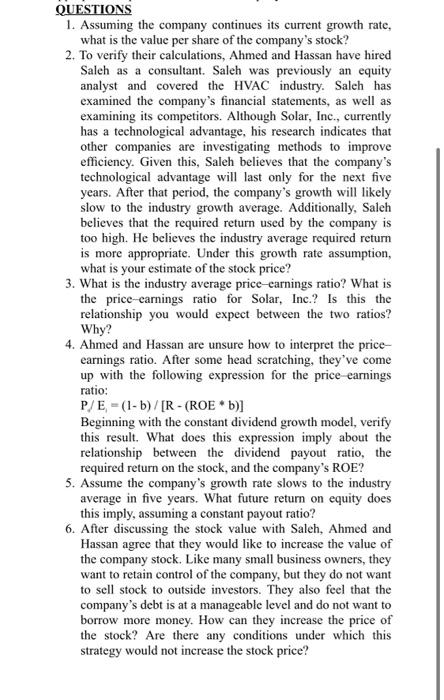Case Study 1: Solar Energy: Stock Valuation Solar Energy, Inc., was founded ten years ago by brothers Ahmed and Hassan. The company manufactures and installs commercial heating, ventilation, and cooling (HVAC) units. Solar, Inc., has experienced rapid growth because of a proprietary technology that increases the energy efficiency of its units. The company is equally owned by both brothers. The original partnership agreement between the them gave each 50,000 shares of stock. In the event either wished to sell stock, the shares first had to be offered to the other at a discounted price. Although neither sibling wants to sell, they have decided they should value their holdings in the company. To get started, they have gathered the following information about their main competitors: Solar Inc., Competitors EPS Dividend per Stock Price ROER Share (DPS) Arctic Cooling, Inc. $ 0.80 S 0.20 $ 14 10% 10% National Heating & Cooling 1.40 0.60 12 12% 13% Expert HVAC Corp. -0.52 0.40 13 14% 12% Industry Average $ 0.56 0.40 13 12% 11.67% Expert HVAC Corporation's negative earnings per share were the result of an accounting write-off last year. Without the write- off, earnings per share for the company would have been $1.06. Last year, Solar, Inc., had an EPS of $4.54 and paid a dividend to Ahmed and Hassan of $63,000 each. The company also had a return on equity of 25%. The siblings believe that 20% is an appropriate required return for the company. QUESTIONS 1. Assuming the company continues its current growth rate, what is the value per share of the company's stock? 2. To verify their calculations, Ahmed and Hassan have hired Saleh as a consultant. Saleh was previously an equity analyst and covered the HVAC industry. Saleh has examined the company's financial statements, as well as examining its competitors. Although Solar, Inc., currently has a technological advantage, his research indicates that other companies are investigating methods to improve efficiency. Given this, Saleh believes that the company's technological advantage will last only for the next five years. After that period, the company's growth will likely slow to the industry growth average. Additionally, Saleh believes that the required return used by the company is too high. He believes the industry average required return is more appropriate. Under this growth rate assumption, what is your estimate of the stock price? 3. What is the industry average price-earnings ratio? What is the price-carnings ratio for Solar, Inc.? Is this the relationship you would expect between the two ratios? Why? 4. Ahmed and Hassan are unsure how to interpret the price- earnings ratio. After some head scratching, they've come up with the following expression for the price earnings ratio: P/E = (1-b) / [R - (ROE* b)] Beginning with the constant dividend growth model, verify this result. What does expression imply about the relationship between the dividend payout ratio, the required return on the stock, and the company's ROE? 5. Assume the company's growth rate slows to the industry average in five years. What future return on equity does this imply, assuming a constant payout ratio? 6. After discussing the stock value with Saleh, Ahmed and Hassan agree that they would like to increase the value of the company stock. Like many small business owners, they want to retain control of the company, but they do not want to sell stock to outside investors. They also feel that the company's debt is at a manageable level and do not want to borrow more money. How can they increase the price of the stock? Are there any conditions under which this strategy would not increase the stock price? Case Study 1: Solar Energy: Stock Valuation Solar Energy, Inc., was founded ten years ago by brothers Ahmed and Hassan. The company manufactures and installs commercial heating, ventilation, and cooling (HVAC) units. Solar, Inc., has experienced rapid growth because of a proprietary technology that increases the energy efficiency of its units. The company is equally owned by both brothers. The original partnership agreement between the them gave each 50,000 shares of stock. In the event either wished to sell stock, the shares first had to be offered to the other at a discounted price. Although neither sibling wants to sell, they have decided they should value their holdings in the company. To get started, they have gathered the following information about their main competitors: Solar Inc., Competitors EPS Dividend per Stock Price ROER Share (DPS) Arctic Cooling, Inc. $ 0.80 S 0.20 $ 14 10% 10% National Heating & Cooling 1.40 0.60 12 12% 13% Expert HVAC Corp. -0.52 0.40 13 14% 12% Industry Average $ 0.56 0.40 13 12% 11.67% Expert HVAC Corporation's negative earnings per share were the result of an accounting write-off last year. Without the write- off, earnings per share for the company would have been $1.06. Last year, Solar, Inc., had an EPS of $4.54 and paid a dividend to Ahmed and Hassan of $63,000 each. The company also had a return on equity of 25%. The siblings believe that 20% is an appropriate required return for the company. QUESTIONS 1. Assuming the company continues its current growth rate, what is the value per share of the company's stock? 2. To verify their calculations, Ahmed and Hassan have hired Saleh as a consultant. Saleh was previously an equity analyst and covered the HVAC industry. Saleh has examined the company's financial statements, as well as examining its competitors. Although Solar, Inc., currently has a technological advantage, his research indicates that other companies are investigating methods to improve efficiency. Given this, Saleh believes that the company's technological advantage will last only for the next five years. After that period, the company's growth will likely slow to the industry growth average. Additionally, Saleh believes that the required return used by the company is too high. He believes the industry average required return is more appropriate. Under this growth rate assumption, what is your estimate of the stock price? 3. What is the industry average price-earnings ratio? What is the price-carnings ratio for Solar, Inc.? Is this the relationship you would expect between the two ratios? Why? 4. Ahmed and Hassan are unsure how to interpret the price- earnings ratio. After some head scratching, they've come up with the following expression for the price earnings ratio: P/E = (1-b) / [R - (ROE* b)] Beginning with the constant dividend growth model, verify this result. What does expression imply about the relationship between the dividend payout ratio, the required return on the stock, and the company's ROE? 5. Assume the company's growth rate slows to the industry average in five years. What future return on equity does this imply, assuming a constant payout ratio? 6. After discussing the stock value with Saleh, Ahmed and Hassan agree that they would like to increase the value of the company stock. Like many small business owners, they want to retain control of the company, but they do not want to sell stock to outside investors. They also feel that the company's debt is at a manageable level and do not want to borrow more money. How can they increase the price of the stock? Are there any conditions under which this strategy would not increase the stock price








